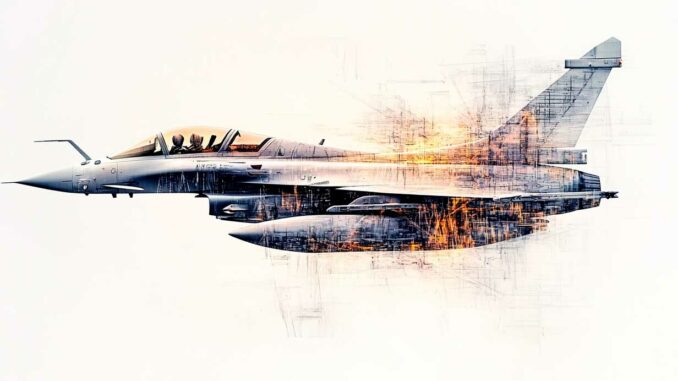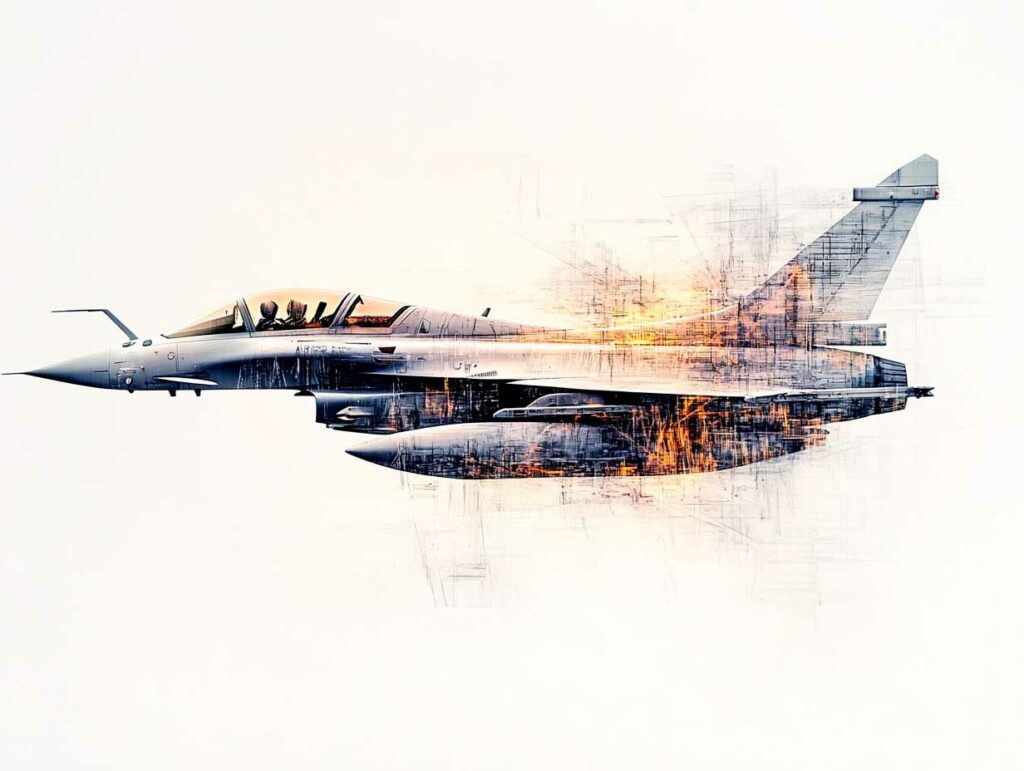
Faced with the Russian threat and transatlantic tensions, Europe is massively reviving its fighter jet programs, led by the F-35.
Europe is experiencing a marked resurgence in investment in combat aviation. Several structural factors are behind this: the persistent Russian threat, US calls for a more autonomous European defense, and tensions caused by Donald Trump’s comments questioning NATO’s historic alliances. Lockheed Martin’s American F-35 fighter jet is establishing itself as the dominant platform, with additional orders on order or planned in Germany, Denmark, Belgium, Italy, the United Kingdom, and Romania. Competing against it, the Eurofighter Typhoon, the Rafale, and the Gripen E are defending their positions with export orders (Qatar, India, Colombia, etc.). Each program includes software upgrades, AESA radars, BVR missiles (Meteor, AARGM-ER, Spear 3) and technological partnerships with combat drones. This accelerated rearmament is preparing Europe for autonomous military projection by 2035–2040.
A strategic reshaping of the European fighter jet market
The European fighter jet market is entering a phase of rapid reconfiguration, driven by two main dynamics: on the one hand, transatlantic political uncertainty embodied by Donald Trump’s potential return to power; on the other, growing security pressures linked to the conflict in Ukraine and Russia’s accelerated militarization.
Since 2022, European countries have increased their defense budgets by more than 30% on average, with peaks of over 40% for countries such as Poland, Finland, and Lithuania. This trend is part of a strategic reassurance strategy in which air fleets, particularly multi-role fighters, are at the heart of the rapid conventional response. The European Union, although divided on its military tools, shares an operational assessment: air sovereignty now depends on platforms equipped with advanced radar systems, long-range weapons and NATO interoperability.
However, structural dependence on US industry remains massive. The F-35 is the standard platform for almost all European countries with NATO commitments. Germany (35 units), Belgium (34), Finland (64), Switzerland (36), Romania (32), the Czech Republic (24), and Denmark (27) have all signed or increased their orders since 2021. Other orders are under negotiation, such as in Spain, Portugal, and Austria. The F-35’s dominance is understandable: costs have stabilized at around €82 million per aircraft, it offers advanced integration of C4ISR networks, and it is natively compatible with NATO standards.
However, this hegemony is worrying some European military leaders, particularly because of the logistical and IT dependencies it creates (maintenance, software updates, dependence on US ALIS/ODIN servers). In the event of serious diplomatic tensions between Washington and Brussels, operational autonomy could be called into question. The situation in Denmark, which is at odds with the US over Greenland, illustrates this vulnerability: despite tensions, Copenhagen is continuing to expand its fleet due to a lack of credible alternatives in the short term.
Behind the illusion of a European consensus on the F-35 lies a structural imbalance, with local industrial options such as the Eurofighter, Rafale, and Gripen under pressure. The strategic strengthening of Europe cannot be envisaged without diversification and independent integration capabilities for its own combat platforms.

The F-35: between industrial dominance and strategic vulnerability
The F-35 Lightning II fighter jet is establishing itself as the backbone of NATO’s European air forces. With more than 600 units ordered or in service in Europe, it far outstrips its competitors. Its success is based on several technical, political, and industrial factors.
Operationally, the F-35 offers 5th generation stealth capability, a comprehensive suite of sensors (AN/APG-81 AESA radar, data fusion, Link 16 tactical data link), and native interconnectivity with NATO C4ISR systems. It is optimized for penetration, reconnaissance, electronic warfare, and ground support missions. The A version, designed for conventional runways, is the best-selling model in Europe. It has a unit cost of approximately $82 million, excluding weapons.
Politically, the aircraft is presented by Washington as a key to interoperability within the Atlantic Alliance. Acquiring the F-35 is seen as a guarantee of strategic loyalty to the United States. This geopolitical logic is prompting several countries to supplement or double their initial orders: Belgium is considering a second batch, Denmark wants to expand its fleet, and Germany is considering increasing its number of units alongside the Eurofighter.
However, this dominant position is accompanied by technical and structural weaknesses. The program is behind schedule on Block 4, the software version that is supposed to integrate European weapons such as the Meteor missile and the Spear 3. Due to the lack of a complete update, several F-35s delivered at the end of 2024 have been limited to training flights. The 40P01 software currently on board does not allow the operational use of certain capabilities that have already been financed by customers.
In addition, the program remains dependent on a centralized digital ecosystem. All maintenance, mission reconfiguration, and update operations are carried out via the ALIS systems (replaced by ODIN), which are hosted in the United States. This direct digital dependency is perceived as a strategic risk by several European military leaders, particularly in the context of political tensions between Brussels and Washington.
Finally, delays in the integration of the Meteor missile—which is essential for operating in European BVR scenarios—are slowing down user autonomy. The United Kingdom and Italy are expecting effective integration by 2030, almost seven years behind the initial commitments.
Despite its technical qualities, the F-35 therefore presents a strategic dilemma: ensuring immediate NATO compatibility at the cost of reduced tactical autonomy and technological control that is partially outside Europe.
The industrial comeback of the Rafale, Typhoon, and Gripen in export negotiations
Despite the dominance of the F-35 in Western Europe, the European fighter jets Rafale, Eurofighter Typhoon and Gripen E are seeing a notable resurgence of interest on international markets. This momentum is based on differentiated strategic choices: limited dependence on the United States, simplified maintenance, increased compatibility with European weapons, and adaptation to local doctrines.
The Rafale from Dassault Aviation has a solid international order book. France delivered 21 aircraft in 2024, out of a total of 220 units on order, guaranteeing more than 10 years of production at the current rate. The most recent contracts include 12 Rafale M aircraft for India, 18 for Serbia, and 80 for the United Arab Emirates. The Indonesian order, initially set at 42 aircraft, could also be expanded. The F4 standard, currently being delivered, adds compatibility with 1,000 kg AASM bombs, the new generation of MICA NG missiles, and tactical connectivity upgrades. The F5 standard, planned for the 2030s, will aim to integrate the ASN4G nuclear missile and cooperate with a combat drone derived from the Neuron demonstrator.
The Typhoon, meanwhile, received new orders in 2024 from Germany (20 units), Spain (25), and Italy (24). The Eurofighter consortium is targeting annual production of 20 to 30 aircraft until the 2030s, gradually integrating upgrades from the P4E package: Mk.1 and Mk.2 AESA radar, SEAD/DEAD capabilities with the AARGM-ER missile, and integration of the Taurus KEPD 350 cruise missile. Saudi Arabia (72 aircraft) and Turkey (up to 40) are in advanced discussions. The Typhoon remains one of the only fighters capable of matching the Rafale in terms of BVR performance in certain access denial doctrines.
The Gripen E from Saab completes this alternative offering. After Brazil (36 aircraft) and Sweden (60 units planned), Colombia and Thailand selected the model in 2025. The Gripen E retains a light logistical footprint, with a cost of ownership less than 50% that of an F-35, and a short take-off capability compatible with secondary airfields. It will also be equipped with the Taurus missile in Sweden by 2030.
Although subject to export restrictions, these three platforms embody a differentiated European approach: rather than a centralized and numerically closed model, they offer flexible interoperability, local maintenance, and enhanced tactical autonomy. In countries concerned about political and industrial balance, these arguments carry considerable weight in purchasing decisions.

Radar, missile, and electronic systems programs as technological differentiators
In the competition between modern combat aircraft, operational advantage is no longer limited to the airframe or engine. Tactical superiority is now defined by radar sensors, BVR missiles, electronic warfare systems, and data fusion capabilities. Europe has understood this and launched specific programs for these components to make its aircraft competitive with the integrated solutions offered by the F-35.
In terms of radar, three variants of the AESA European Common Radar System (ECRS) are currently being deployed. The Mk.0 is already fitted to Kuwaiti and Qatari Typhoons. The Mk.1, developed by Hensoldt, will be installed on German Typhoons (Tranches 2 to 4) and on new Spanish aircraft. Finally, the Mk.2, designed by Leonardo UK, provides active electronic attack capability. It made its first test flight in September 2023 and will be fitted to the Royal Air Force’s Phase 3 aircraft by 2030.
These radars are essential for maximizing the performance of long-range missiles such as MBDA’s Meteor. This active ramjet air-to-air missile maintains its thrust in the terminal phase, improving the probability of neutralization in the BVR zone. It is integrated into the Rafale and Typhoon and should be fully integrated into the European F-35 by the end of 2029. This 5-6 year delay reveals a technical and political gap between European customers and the US validation process.
Northrop Grumman’s AARGM-ER is also being integrated, mainly on the Typhoon for Germany and Italy, as part of SEAD/DEAD capabilities. These systems enable the detection, location, and neutralization of enemy ground-to-air defenses, including S-300 and S-400 batteries. The Taurus KEPD 350 cruise missile is currently being adopted on the Gripen C/D in Sweden and is already in service on German Typhoons.
The Typhoon’s Phase 4 Enhancements (P4E) program brings together all of these integrations: weaponry, mission management by objectives, reduction of pilot workload, and improved countermeasures. This is the most complex modernization package ever carried out on a multinational European platform.
These enhancements are necessary to maintain the operational relevance of the fleets until 2060, the date now set for the gradual withdrawal of the current Eurofighters and Rafales. As interception technologies evolve, particularly with hypersonic missiles and multiband radars, the ability to rapidly adapt onboard systems is becoming a factor in operational survival.
Towards European air technology sovereignty under pressure
The proliferation of fighter aircraft programs in Europe masks a more complex reality: that of still incomplete technological sovereignty, subject to industrial, political, and strategic pressures. Although initiatives such as FCAS (France, Germany, Spain) and GCAP (United Kingdom, Italy, Japan) are underway, they will not result in operational platforms until 2040 at the earliest. Until then, European air forces will have to rely on a mix of modernized existing aircraft and emerging technologies.
The situation is paradoxical. On the one hand, Europe has three modern fighter jets (Rafale, Typhoon, Gripen) capable of operating with a high degree of autonomy and integrating into NATO architectures. On the other hand, it remains dependent on imported critical technologies for electronic components, certain weapons, and even simulators and mission software. Logistical dependence on the F-35 exacerbates this vulnerability, particularly in the event of diplomatic tensions with the United States.
The risk is twofold. On the military front, a break in the supply chain or software update could affect the availability of the entire European F-35 fleet. On the industrial front, the lack of a common standardization effort limits economies of scale, weakens export competitiveness, and complicates interoperable maintenance.
To maintain its independent capacity for action, Europe will have to meet three requirements:
- Strengthen its critical supply chains (semiconductors, engines, radars, missiles) with fast-track programs.
- Invest in dual-use technologies (drones, embedded AI, electronic warfare) capable of extending the relevance of current fleets.
- Structure a coherent industrial model between partner countries to avoid fragmentation.
The Swedish example is worth watching closely. In parallel with the Gripen E, Stockholm is preparing a decision in 2030 to launch a national combat aircraft program, potentially independent of FCAS and GCAP. This project could create a third European option, focused on light, autonomous platforms that are interconnected with NATO systems. By engaging GKN Aerospace and Saab, Sweden is laying the industrial foundations for long-term sovereign capability.
Conversely, countries such as Poland, which are considering purchasing a second batch of F-35s, as well as F-15EXs and F-16 Block 70s, are locking themselves into a logic of complete dependence on the US military industry, despite obvious geopolitical tensions. This strategic asymmetry weakens the resilience of the entire European system in the event of a breakdown in transatlantic alignment.
By 2035–2040, the issue will therefore not only be one of air performance, but also one of strategic independence. If Europe wants to carry military weight without being a subcontractor for US decisions, it will have to make clear, coordinated industrial choices backed by sustained political will—which, to date, is far from guaranteed.
War Wings Daily is an independant magazine.